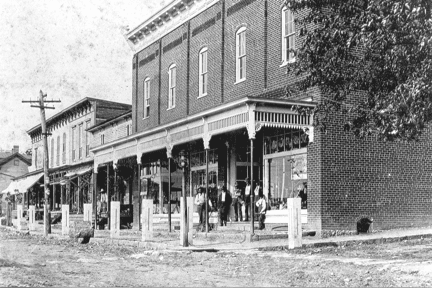
When German settlers came to the Custer’s Mill (Broadway) area of the Shenandoah Valley in the mid 1700’s, they probably noticed that the landscape was quite similar to their homeland. The tall mountains and secluded valleys resemble the German countryside in many ways. As mentioned in the last post, a little settlement began to grow near the Linville Creek. Folks built homes and tended farms next to a mill owned by a businessman by the name of Conrad Custer. Many houses and businesses — including Conrad Custer’s mill — were destroyed during Sheridan’s raid on the Valley. But the spirit of the little town was not squelched for long. The citizens began building back their homes and workplaces.
In 1868, Irish workers moved to the area to begin construction of the railroad. The day the first train came through town was a time of celebration. Folks left work and children were excused from school to witness this monumental event.
The arrival of the railroad brought many changes to the town. Two hotels and several boarding houses were the first signs of a growing economy. The poultry industry was also boosted by this new form of transportation. Chickens, turkeys, ducks and eggs were shipped from the Broadway depot on a regular basis. In the month of March, 1878, town depot records show that 10,000 eggs were packed on the train and transported to various places up and down the valley.
In 1880, the town boasted thirty-three businesses. Among them were a large pottery, two mills, a tannery, a lime kiln, five general stores, a drug store, a foundry with a machine shop, a hardware store, three churches and a opera house.
In the midst of this commerce and activity, a visionary came to town. Mr. E.D. Root had enormous plans for this booming little town. His first task was to start a newspaper. After that, he started to seek funding for some of his other dreams. He even traveled to Wall Street to try to convince money moguls to help turn this little town into a center of trade and commerce. Root was sure that Broadway could become the leading city in the Shenandoah Valley because of its location and rich mineral and timber resources.
There doesn’t seem to be one particular cause for the failure of Root’s grand dreams. But despite the thriving economy and the grand possibilities the town seemed to possess, Root was unable to convince others to buy into his scheme. Eventually he moved out of the area, and Broadway remained a charming little town.
Even though a grand hotel doesn’t rest on the town square and Broadway is not a center of commerce for the Shenandoah Valley, it’s still a pleasant place to live. Folks possess the same kind, caring concern for their neighbors as do the citizens of our fictional town — Custer’s Mill. It’s quite nice to be part of both worlds: the real world of Broadway, Virginia and the fictional world of Custer’s Mill, Virginia.
(Information for this post: Local Lore of the Shenandoah by Retta Lilliendahl and Tammy Fulk Cullers)
 RSS Feed
RSS Feed
